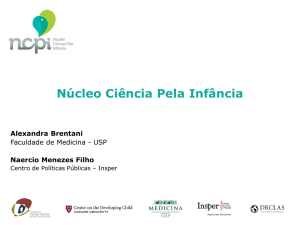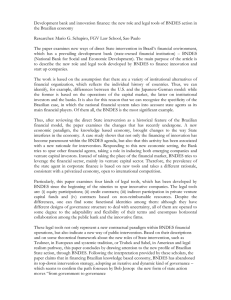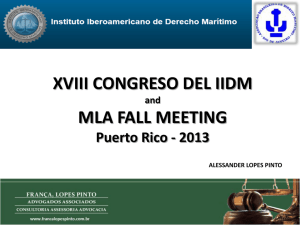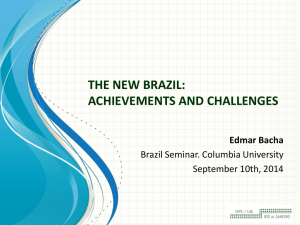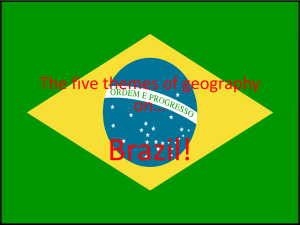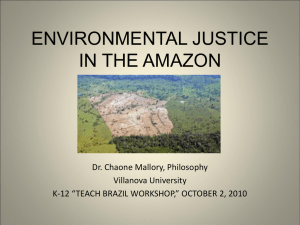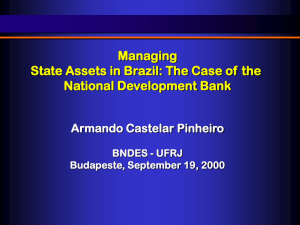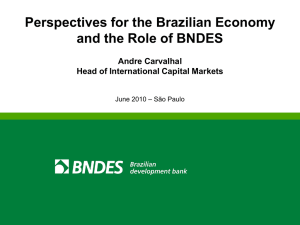Agriculture, Sustainability and Social Issues in Brazil
advertisement
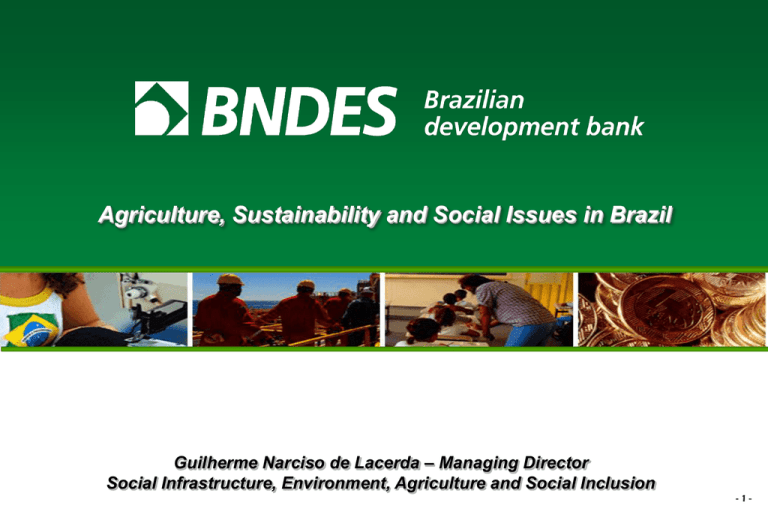
Agriculture, Sustainability and Social Issues in Brazil Guilherme Narciso de Lacerda – Managing Director Social Infrastructure, Environment, Agriculture and Social Inclusion -1- Summary 1. Brazil Panorama Agriculture and Brazilian Economy; The Development of Modern Agriculture in Brazil; Key factors contributing to the recent development of Brazilian Agriculture Production Models: family farming and agribusiness 2. Agriculture: A profitable business Agribusiness in Brazil – Exports; Exports - Main destinations and products (2012) Brazilian Agriculture World Rankings - 2012); 3. Agriculture: A path to social inclusion Brazil’s Social Programs; Rural Poverty - 2010 Public Policies for Family Farming; Institutional Food Markets and land distribution 4. Agriculture: Challenges to sustainability Agriculture and Climate Change; Deforestation Rates in Brazil and the Amazon Fund; The Low Carbon Agriculture Plan 5. BNDES Overview and challenges -2- 1. Agriculture in Brazil: Brazil Panorama Agribusiness Agriculture Social inclusion Sustainability -3- Agriculture and the Brazilian Economy Milllion Population Growth 180 % of the country’s population 160 140 120 1960 55% 2010 16% 100 80 60 40 20 0 1960 Censo IBGE 2010 1970 1980 1991 Country population 2000 2010 Urban population Brazilian GDP(2011) Source: IBGE 2010, CEPEA-USP GDP in the agri-industrial system Total US$ 2.46 tri Inputs Ag. 22.15% (US$ 549 bn) 11.8% Agriculture Industry Distribution 28.5% 30.9% Cattle-raising 28.8% -4- The Development of Modern Agriculture in Brazil Brazilian Agriculture today Brazilian Agriculture until the 1970’s One of the leading producers on Earth; Low Agricultural production and low yields (crops at 34,000 million. ha); Production spread over central states; Increasing productivity; Production concentrated in South/Southeast; Lack of specific knowledge on Tropical Agriculture; Institutional void (agricultural research, education, markets, media governmental agencies etc.). The task: To move from traditional agriculture to that based on science & technology Increasing use of technology and specific knowledge for the different biomes; M.Lopes (2011). Increasing presence of social movements; Significant government participation in implementing specific policies for the sector. Challenge: To maintain sustainable and inclusive growth -5- Grains and Oilseed Production, Area and Yield (1976 – 2013) 299% 43% 179% Yield (Kg/ha) Production (million tons) and area (million ha) Variation, 1976/77 to 2012/13 Source: Conab. -6- Recent Development of Brazilian Agriculture Key factors Entrepreneurship of farmers Government commitment Climatic conditions Large extension of arable land ‘ Science-based tropical agriculture -7- Production models: family farming and agribusiness Family farming Non Family farming ECONOMICALLY ACTIVE POPULATION (%) Source: IBGE, 2006 ECONOMICALLY ACTIVE POPULATION (million) -8- 2. Agriculture: A profitable business Agribusiness Agriculture -9- Agribusiness in Brazil: Exports Brazilian Foreign Trade (US$ billion) Exports (2012) Brazilian Agribusiness Trade Balance Brazilian Trade Balance Result TOTAL (US$242,6 bi) 41% (US$ 99.6 bn) Sources: CEPEA/USP, CNA, IPEA, MAPA and MDIC. Elaborated by: Fiesp-Deagro. Note:* from March ‘12 to April ‘13 - 10 - Exports - Main destinations and products (2012) Main destinations (US$ billion) Main products (US$ billion) Sources: MAPA and MDIC / 2012 - 11 - Production Exports Brazilian Agriculture World Rankings - 2012 Orange Juice Sugar Coffee Beef Soy Complex Broiler Corn Pork 1st 1st 1st 1st 1st 1st 2nd 4th 81% 45% 28% 19% 31% 35% 22% 9% 1st 1st 1st 2nd 2nd 3rd 3th 4th 57% 22% 37% 16% 24% 15% 9% 3% Source: USDA (May ‘13). Note: harvest 2012/13 and 2012 for meats Elaborated by: Fiesp-Deagro. - 12 - 3. Agriculture: A path to social inclusion Agriculture Social inclusion - 13 - Brazil’s Social Programs Over the last few years, the number of people living in poverty and extreme poverty has fallen. This is due to economic growth and political decisions. Temporal evolution of extreme poverty (% of population): Brazil from 2001 to 2011 9.9 9.03 7.9 7.58 7.01 5.73 2001 2002 2003 2004 Extreme poverty: Income below R$70 per capita/month 2005 2006 5.67 2007 4.77 4.61 4.38 2008 2009 2011 Source: PNAD - 14 - Ongoing economic inclusion fuels a dynamic market Population by income class strata (% of people)* * Source: IPEA, based on PNAD/IBGE data. Prepared by Ministry of Finance - 15 - Rural Poverty - 2010 Census 2010 Brazil’s population – 190.7 million 15.6% of Brazil’s population lives in rural areas 16.2 million Brazilians living in extreme poverty 47% of these are in rural areas In rural areas, one out of four live in extreme poverty – 25.5% IBGE - 16 - Public Policies for Family Farming Policy Instruments Land distribution Technical aid and rural extension Infrastructure Credit Instruments ENHANCED PRODUCTION / PRODUCTIVITY Access to markets Food Security - 17 - Institutional Food Markets 1. Food Purchase Program (Programa de Aquisição de Alimentos – PAA) Established in 2003, this program consists of the government buying food from family farmers without bureaucratic barriers. Numbers 2003 – 2011: US$ 1,45 billion, average of 160,000 families per year 2. National School Food Program (Programa Nacional de Alimentação Escolar) Established in 2009 How much – 30% of food budget Who Sells – Family Farmers Who Buys – Municipal and State Department of Education Priority for local production 250,000 families and 47 million students potentially benefited US$ = R$2,20 - 18 - Agriculture: Challenges to sustainability Agriculture Sustainability - 19 - Agriculture and Climate Change Agriculture THREATENED Agriculture AS A THREAT Agriculture AS A FRIEND Temperature raising; Land Use Changes; Sequestration of GGEs; Drought and Flood; Deforestation; Pests and diseases; Soil degradation; GGE emission reductions (no till, pasture recovery); Loss of productivity; GGE emissions (cattle raising; nitrogen fertilizers); Salinization; Avoided emissions: REDD plus; Manure management. Elaboration: ICONE - 20 - Land-use in Brazil (2011) 554 million/ha of native vegetation 65% 60 million/ha of production area (grains, fruits and planted forests) 7% 38 million/ha urban areas and other destinations 4% 198 million/ha of pastures 17% Sources: Ministério do Meio Ambiente - MMA; IBGE – PAM (2010) e Censo Agropecuário (2006); INPE – TerraClass; Agricultural Land Use and Expansion Model Brazil - AgLUE-BR (Gerd Sparovek, ESALQ-USP). Notas 1) Os dados de Unidades de Conservação excluem as chamadas Áreas de Proteção Ambiental – APAs; 2) Os dados de APPs consideram vegetação nativa ripária, em topo de morros e encostas; 3) O dado de remanescentes de vegetação nativa inclui terras quilombolas, florestas públicas não regularizadas e outros remanescentes de vegetação nativa. - 21 - Brazilian biomes: challenge for agricultural policies Brazilian Biomes Area Total Preserved (million Km2) (%) Amazonia Cerrado Atlantic forest Caatinga Pampa Pantanal TOTAL 4,2 2,0 1,1 0,8 0,2 0,1 8,4 85 61 27 63 41 89 69 Source: Embrapa (Pesq. Agrop . Bras.) - 22 - Deforestation rates in Brazil Deforested area in the Amazon Biome (km²) 30000 km² 25000 20000 Average deforestation rate (1996 - 2005) 19.625 km² Average deforestation rate (2001 - 2010) 16,531 km² 15000 10000 5000 0 1996 1997 1998 1999 2000 2001 2002 2003 2004 2005 2006 2007 2008 2009 2010 2011 2012 The Amazon Fund is an extremely important initiative to support Brazil’ s efforts aimed at combating deforestation in the Amazon. In the last few years, Brazil has obtained huge results from this. - 23 - The Amazon Fund • Managed by the BNDES • Created in 2009 with grants from the Government of Norway. • Donations are based on prevented deforestation for non-reimbursable projects. • 43 supported projects (US$273 million) including one that involves all countries within the Amazon biome. US$ = R$2,20 www.fundoamazonia.gov.br - 24 - Greenhouse Gas Emissions - Brazil Land-use Energy Supply Agriculture Industry Waste Sectors Land-Use Agriculture Energy Supply Industry Waste Total Millions of tCO2e Emissions Emissions Var. 20052005 2010 2010 1.168 279 -76.10% 416 437 5.20% 329 399 21.40% 78 82 5.30% 42 49 16.40% 2.032 1.246 -38.70% - 25 - The “Low-Carbon Agriculture” Plan (ABC) • Launched in 2010 • Aims to stimulate new sustainable agriculture, reducing global warming and mitigating carbon emissions • 6 initiatives with goals up to 2020 - 26 - The “Low-Carbon Agriculture” Plan (ABC) No-tillage system Expand the current 26 million hectares to 33 million hectares of crops established by no-till. Reduce 16 to 20 million tons of carbon emissions. Recovery of Degraded Pastures Goal to transform degraded land into areas suitable for the production of food, fiber, meat and forests, thus recovering 15 million hectares and reducing between 83 and 104 million tons of CO2 equivalent. Crop-Livestock-Forest Integration Increase system utilization by 4 million hectares and reduce 18 to 22 million tons of carbon emissions by 2020. Biological Nitrogen Fixation Planted Forests Animal waste treatment TOTAL Source: MAPA. The goal is to encourage the use of this technique in the production of 5.5 million hectares, and reduce the emission of 10 million tons of CO2 equivalent. Expand planted forest area in 3 million ha, reaching 9 million hectares Treat 4.4 million m³ of waste from pig farming and other activities, thus preventing 6.9 million tons of CO2 equivalent from being released into the atmosphere. Reduce the emission of 134 to 163 million tons of CO2 by 2020 Elaborated by: Fiesp-Deagro. - 27 - BNDES Overview and Challenges - 28 - BNDES - Overview Founded in 1952 as a wholly-owned federal company Key instrument for implementing the federal government’s economic policies Main provider of long-term financing in Brazil Emphasis on financing investment projects Support for exports and the internationalization of Brazilian companies Small and Medium enterprises – 32% of all disbursed during 2012 In 2012, the BNDES disbursed US$ 78.7 billion in debt, equity and grant instruments. - 29 - Agriculture at BNDES Who does BNDES supports? Family farmers Cooperatives Medium and big producers Trading companies Industry What does BNDES supports? ‘ Investment projects and associated working capital Machinery Innovation Infraestructure Irrigation - 30 - Challenges Production CROP Productivity/Yields Sustainability Social Inclusion Reinvestment Funding Distribution Commercializ ation - 31 - Guilherme Narciso de Lacerda guilherme.lacerda@bndes.gov.br www.bndes.gov.br
